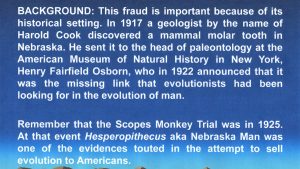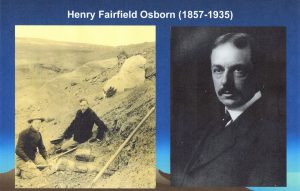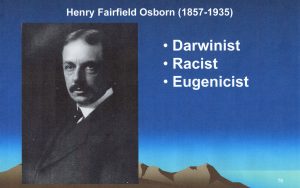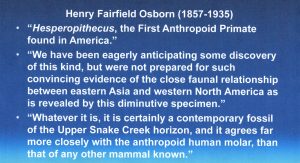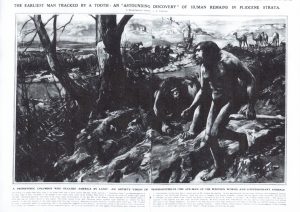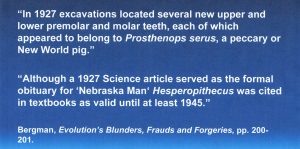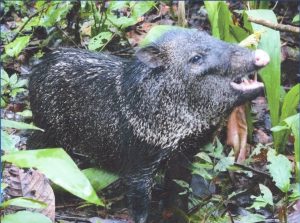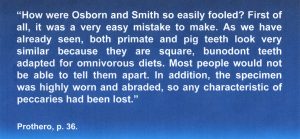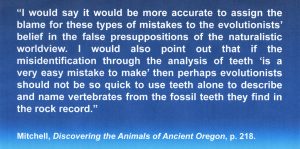This article is based on one section of a PowerPoint presentation that I did for the Design Science Association of Portland in May 2024. The title of the talk was “Evolution’s 14 Greatest Frauds” where Nebraska Man was listed as fraud number 7. Nebraska Man (Hesperopithecus) was one of the most famous of the many 20th century evolutionist goof-ups. I have also written about this in several of my books.
The driving character behind this mistake was Henry Osborn. He was head of paleontology at the American Museum of Natural History in New York for 25 years, and he was the primary force for developing the museum’s paleontology displays from nothing to be among the best in America.
Slide #2
In Slide #2 the left-hand photo shows Osborn in the field with dinosaur hunter Barnum Brown in 1897 (Brown is on the left). The right-hand photo of Osborn was taken some time later.
Slide #3
Osborn was on the cover of Time magazine in 1928, had a tremendous ego, and was called an arrogant, bigoted tyrant by some of his associates. He was a noted Darwinist, racist, and eugenicist. He was quoted as saying of himself that he was a great man.
Once he had in his possession the mammal tooth that Mr. Cook had found, Osborn used all his influence to become a forceful proponent of the tooth being from an ape-man. Slide #4 contains some of what he said in his paper in the May 5, 1922 issue of Science magazine.
Slide #4
One result of Osbron’s announcement in Science magazine was that the June 24, 1922 issue of the Illustrated London News made a big deal of Hesperopithecus and called out the tooth as belonging to “Nebraska Man.” The big Illustrated London News layout hyping the finding of the first fossil evidence for ape-man in America is shown in Slide #5. The artistic rendition of Nebraska Man and his companion showed hairy and stooped bipedal creatures in a scene with extinct camels in the background. The caption provided many of the details that had been announced by Osborn.
Then in the August 26, 1922 issue of Nature Osborn got personal with swipes at anti-Darwinist William Jennings Bryan (of the 1925 Scopes trial). Osborn ridiculed Bryan’s reliance on the Bible and told him he should read Job 12:8 about the earth that says, “Speak to the earth and it shall teach thee.” He then wrote the words seen in Slide #6.
Slide #6
Osborn was basically saying that Bryan needed to understand that the fossils (teeth) from the rock record of the earth had priority over God’s Word, and that his evolutionist religion had replaced the Bible regarding ancient history. Slide #7 illustrates the scientific evidence from Nature upon which Osborn rested his case. The Nebraska Man tooth was shown in views 1 and 4 in comparison with other mammal teeth.
Slide #7
Also, in Slide #7 tooth 2 was from a young chimpanzee, tooth 3 was from Pithecanthropus another supposed ape-man of the time, tooth 5 was from a North American Indian, and tooth 6 was from another chimpanzee. The choice of teeth highlights the fact that Osborn assumed all primates had evolved from a common ancestor.
Soon several other teeth were uncovered in the same area where the first tooth was found and they were almost identical to the Nebraska Man tooth, except they were in much better condition. From these teeth it was clear that all the teeth from the area were from a peccary. The conclusions after the discovery of these teeth are stated in Slide #8.
Slide #8
Most people would have an idea of what a peccary looks like. I have inserted a photo of one on Slide #9. Notice that the Nebraska Man idea did not die easily.
Slide #9 – Peccary
How do the evolutionists explain this screw-up? The explanation from two of them is seen in Slide #10. This is from the book by paleontologists Donald Prothero and Robert Schoch, Horns, Tusks, & Flippers—The Evolution of Hoofed Mammals, 2002, p. 36. They rejected the scorn of Christian fundamentalists and then wrote what is in Slide #10.
Slide #10
As a fundamentalist myself I wrote a response to Prothero and Schoch as seen in Slide #11.
Slide #11
J.D. Mitchell
